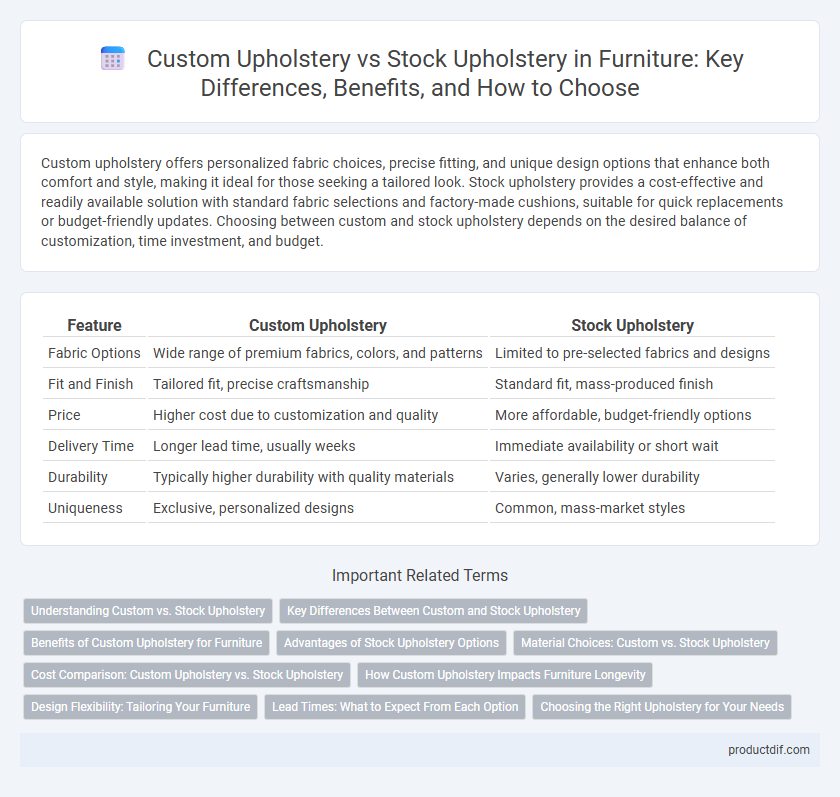Custom upholstery offers personalized fabric choices, precise fitting, and unique design options that enhance both comfort and style, making it ideal for those seeking a tailored look. Stock upholstery provides a cost-effective and readily available solution with standard fabric selections and factory-made cushions, suitable for quick replacements or budget-friendly updates. Choosing between custom and stock upholstery depends on the desired balance of customization, time investment, and budget.
Table of Comparison
| Feature | Custom Upholstery | Stock Upholstery |
|---|---|---|
| Fabric Options | Wide range of premium fabrics, colors, and patterns | Limited to pre-selected fabrics and designs |
| Fit and Finish | Tailored fit, precise craftsmanship | Standard fit, mass-produced finish |
| Price | Higher cost due to customization and quality | More affordable, budget-friendly options |
| Delivery Time | Longer lead time, usually weeks | Immediate availability or short wait |
| Durability | Typically higher durability with quality materials | Varies, generally lower durability |
| Uniqueness | Exclusive, personalized designs | Common, mass-market styles |
Understanding Custom vs. Stock Upholstery
Custom upholstery offers personalized fabric choices, precise fitting, and unique design options tailored to individual preferences, enhancing comfort and aesthetic appeal. Stock upholstery typically provides pre-selected fabrics and standard sizes, allowing for faster production and lower costs but limited customization. Understanding these differences helps consumers balance between bespoke quality and budget-friendly convenience in furniture upholstery.
Key Differences Between Custom and Stock Upholstery
Custom upholstery offers personalized fabric choices, tailored measurements, and unique design options, ensuring a perfect fit and individual style. Stock upholstery provides mass-produced materials and standard sizes, leading to quicker availability and lower costs but limited customization. Key differences include the level of personalization, material quality, production time, and pricing flexibility.
Benefits of Custom Upholstery for Furniture
Custom upholstery offers tailored fabric choices, precise fit, and personalized design, enhancing comfort and style to match specific interior decor. It increases furniture longevity by using high-quality, durable materials selected to withstand individual usage patterns. Customization also allows for unique detailing and color options, providing a one-of-a-kind piece that complements the homeowner's aesthetic preferences and spatial requirements.
Advantages of Stock Upholstery Options
Stock upholstery options offer immediate availability, making it ideal for quick furniture updates or replacements. These pre-selected fabrics ensure consistent quality and standardized sizing, reducing the risk of errors during production. Economically, stock choices tend to be more budget-friendly due to mass production and lower material costs.
Material Choices: Custom vs. Stock Upholstery
Custom upholstery offers a wide range of material choices, including premium leathers, high-performance fabrics, and eco-friendly options tailored to individual preferences. Stock upholstery typically features limited material selections, often prioritizing durability and cost-effectiveness over personalized aesthetics. Selecting custom materials allows for enhanced comfort, unique textures, and color matching that aligns precisely with interior design schemes.
Cost Comparison: Custom Upholstery vs. Stock Upholstery
Custom upholstery typically incurs higher costs due to premium materials, labor-intensive craftsmanship, and personalized design options, often ranging from 30% to 50% more than stock upholstery prices. Stock upholstery offers budget-friendly alternatives with mass-produced fabrics and standardized designs, leading to lower upfront expenses and faster availability. Choosing between custom and stock upholstery depends on balancing the initial investment with desired quality, durability, and unique aesthetic preferences.
How Custom Upholstery Impacts Furniture Longevity
Custom upholstery significantly enhances furniture longevity by using higher-quality materials tailored to withstand specific usage patterns, unlike stock upholstery, which often employs generic fabrics prone to faster wear and tear. Craftsmen select durable fabrics, reinforced stitching, and specialized padding in custom upholstery, extending the lifespan of sofas, chairs, and ottomans well beyond standard industry expectations. This personalized approach not only maintains structural integrity but also preserves aesthetic appeal, resulting in investment pieces that remain functional and attractive for decades.
Design Flexibility: Tailoring Your Furniture
Custom upholstery offers unparalleled design flexibility, allowing you to select fabrics, patterns, and textures that perfectly match your personal style and home decor. Unlike stock upholstery, which is limited to predefined options and standard dimensions, custom options enable precise tailoring for unique furniture shapes and sizes. This personalized approach ensures a cohesive and distinctive look that enhances both comfort and aesthetic appeal.
Lead Times: What to Expect From Each Option
Custom upholstery typically involves lead times of four to eight weeks, depending on fabric selection, design complexity, and artisan availability. Stock upholstery offers significantly shorter lead times, often ranging from one day to two weeks, due to pre-manufactured fabrics and standardized designs. Understanding these timeframes helps consumers balance personalization desires against project deadlines in furniture procurement.
Choosing the Right Upholstery for Your Needs
Custom upholstery provides personalized fabric choices, tailored measurements, and unique design options, making it ideal for achieving exact style and comfort preferences. Stock upholstery offers convenience and affordability with pre-selected materials and standard sizes, suitable for quick replacements or budget-conscious projects. Evaluating factors like budget, style flexibility, comfort requirements, and project timeline helps determine the most suitable upholstery option.
Custom upholstery vs stock upholstery Infographic

 productdif.com
productdif.com